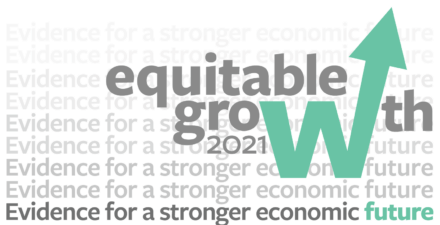Brad DeLong: Worthy reads on equitable growth, September 14-20, 2021
Worthy reads from Equitable Growth:
1. The stakes involved in pushing the U.S. congressional reconciliation bill to the goalposts are very large indeed. Read Alix Gould-Werth and Sam Abbott, “Congressional investments in social infrastructure would support immediate and long-term U.S. economic growth,” in which they write: “President Joe Biden’s Build Back Better agenda … boasts the potential to reshape the U.S. economy … [by] supporting workers and families with investments in care infrastructure, including a comprehensive paid family and medical leave program and increased investment in early care and education, as well as income supports, such as a permanent fully refundable Child Tax Credit and structural reforms to the Unemployment Insurance program. Common sense, as well as a robust body of research, suggests these investments would improve workers’ and families’ personal well-being, especially for families of color. …. But policymakers should not lose sight of the economywide impact these investments will have as well.”
2. This will, I think, be Equitable Growth’s best policy conference yet—if only because the United States now has huge amounts of running room given the chaos caused by the coronavirus pandemic and by the ongoing disruptions to U.S. politics I believe its aftermath is likely to bring. Read Maryam Janani-Flores, Kate Bahn, and Carmen Sanchez Cumming, “Equitable Growth’s 2021 policy conference features key speakers and panelists discussing inclusive U.S. economic growth after the coronavirus recession,” in which they write: “More expansive, more transformative, and more equitable economic policies have helped power a far more rapid recovery, compared to the years following the Great Recession. … Our virtual policy conference … [features] pathbreaking leadership and cutting-edge scholarship that recognizes how a stronger economic future is built on the linkages between racial justice, climate resilience, access to care and family economic security, financial stability, and rebalancing power, so that all can share in the gains of economic growth. Headlining the conference in a series of fireside chats and remarks are the new Equitable Growth President and CEO Michelle Holder, U.S. Secretary of Labor Marty Walsh, U.S. Rep. Hakeem Jeffries (D-NY), Michigan State University economist and Equitable Growth Steering Committee member Lisa Cook, University of California, San Diego assistant finance professor Carlos Fernando Avenancio-León, and Marketplace host and correspondent Kimberly Adams.”
Worthy reads not from Equitable Growth:
1. That technological disruption affects U.S. workers already in declining industries but does not harm the prospects of future entrants may be a durable lesson from the past of technological disruption and change. Read James Feigenbaum and Daniel P. Gross, “Automation and the Future of Young Workers: Evidence from Telephone Operation in the Early 20th Century,” in which they write: “Telephone operation, one of the most common jobs for young American women in the early 1900s, provided hundreds of thousands of female workers a pathway into the labor force. Between 1920 and 1940, AT&T adopted mechanical switching technology in more than half of the U.S. telephone network, replacing manual operation. Although automation eliminated most of these jobs, it did not affect future cohorts’ overall employment: the decline in demand for operators was counteracted by growth in both middle-skill jobs like secretarial work and lower-wage service jobs, which absorbed future generations. Using a new genealogy-based census linking method, we show that incumbent telephone operators were most impacted by automation, and a decade later were more likely to be in lower-paying occupations or have left the labor force entirely.”
2. The point of Critical Race Theory: don’t make African Americans poor and excluded from networks, keep them poor and excluded from networks, then discriminate against the poor and those excluded from networks, and claim that you are not then discriminating on the basis of race. Read Noah Smith, “The Negro Subversive on Critical Race Theory,” in which he writes: Critical Race Theory’s founders sought to understand how a society that had officially disowned racism managed to continue being racist. … To understand how law impacts society, we must understand how law exists in society, which means applying insights from … the social sciences. … What all three social objects under the name “Critical Race Theory,” have in common is the idea of politicizing the allegedly apolitical. … The social sciences … rose in the midst of various national projects and served to justify them. Their (very incomplete) transition away from this heritage has traced an arc similar to their growth toward greater objectivity. The legacy of this transition continues, as the social sciences both reflect and condition how the public thinks about society. The fault lines of the critical race theory “debate,” reflect the fault lines early social science practitioners faced as they developed their disciplines out of “social philosophy,” into social science. Recognizing that these faults still condition our thinking about the social world is crucial to recognizing what’s at stake right now.”




